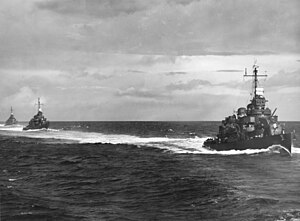Battle of Horaniu
| date | August 17, 1943 |
|---|---|
| place | in front of Vella Lavella , Solomon Islands , Pacific |
| output | strategic Japanese victory |
| Parties to the conflict | |
|---|---|
| Commander | |
| Troop strength | |
| 4 destroyers | 4 destroyers 20 landing craft transport ships |
| losses | |
|
no |
1 destroyer damaged |
The Battle of Horaniu was a naval battle between the United States of America and the Japanese during the Pacific War . It took place on the night of August 17-18 , 1943 near Horaniu , a Japanese base on Vella Lavella in the Solomon Islands .
prehistory
After the lost battle in the Vella Gulf , the Japanese decided to withdraw all troops south of Bougainville . In Horaniu , at the northernmost point of Vella Lavella, they had set up a loading point for their landing craft. A convoy of 20 landing craft and other support ships protected by four destroyers ( Sazanami , Hamakaze , Isokaze , Shigure ) under the command of Rear Admiral Matsuji Ijuin ran from Horaniu to the eastern island of Kolombangara on August 17 to take the troops stationed there on board .
The battle
Rear Admiral Wilkinson was informed of the Japanese movements through aerial reconnaissance . Then he gave Captain Thomas J. Ryan with his destroyer group ( Nicholas , O'Bannon , Taylor , Chevalier ) the order to intercept the Japanese convoy.
At 11:30 p.m. the convoy was attacked by American Grumman TBF torpedo planes . He was therefore out of formation when he was discovered by the American destroyer group at 12:29 a.m. Ryan thought that the Japanese had not yet discovered him and was about to carry out a surprise attack with torpedoes when his ships were discovered by a Japanese reconnaissance plane and illuminated with flares. After a torpedo duel, which had no effect, and long-range artillery fire, which apart from a close hit at the Hamakaze , which caused only minor damage, also had no consequences, the Japanese withdrew.
Result
The battle was a strategic victory for the Japanese, as they were able to save the majority of their landing craft and later withdraw 9,000 men.
Web links
- Battle description by Vincent O'Hara ( English )
